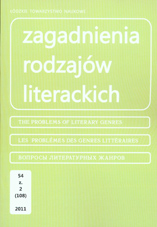Stwarzanie dyskursu z buntu
Making discourse based on negation – in Tadeusz Kantor’s writings
Author(s): Paweł StangretSubject(s): Literary Texts
Published by: Łódzkie Towarzystwo Naukowe
Summary/Abstract: Tadeusz Kantor's texts are great example of critical way of thinking. The artist said about himself as a heretic and rebel. His criticism way Kantor showed expecially in The Milano Lessons. On the one hand, Kantor was against post−modern ideas of art. (expecially conceptual art and open work of art). On the another hand he created his own positive conception. In 1986 he reminded constructivism and created himself as a constructivist. In Kantor's writings it is apparent − his revolt was against "official vanguard" (as he called this phenomenon) which took place in the second half of XX−th century. He had opponent and he also had an ally. Kantor created his own authorities and set himself as a successor of constructivism. Kantor's criticism is interesting, because he was using not only negation, but he was building tradition and authorities. His rebellion was focused on reminding tradition. He called himself as a constructivist and that's why he was heretic and rebel. Kantor's criticism was build in the positive way − by creation another, opposite discourse. Anyway, he did it in his texts. This was opposite to the contemporary of him conception of art, which joined theory and work of art. In Kantor's work there was strong and clear border. It is also important for us today − we can only read his texts and it is apparent that Kantor criticized not only artistic ideas but also wider − he thought about contemporary and future culture.
Journal: Zagadnienia Rodzajów Literackich
- Issue Year: 54/2011
- Issue No: 2
- Page Range: 163-182
- Page Count: 20
- Language: Polish

